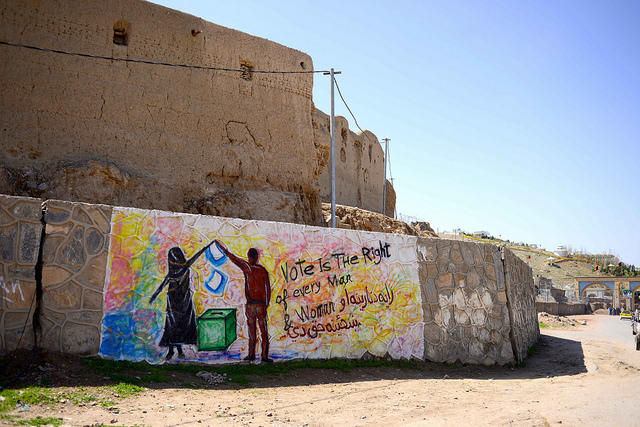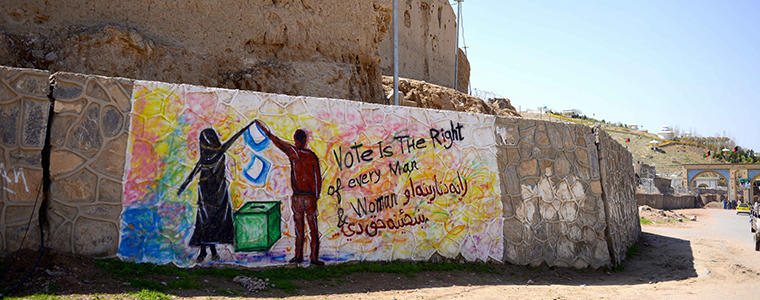The only way for Afghanistan to avert electoral disaster is if the Ghani government and parliament act together to take cohesive and swift action.

In 2014, Afghanistan’s presidential election was marred by accusations of fraud. U.S. Secretary of State John Kerry intervened and brought together the two candidates, Mohammad Ashraf Ghani and Abdullah Abdullah, to form what is now the National Unity Government (NUG), with Ghani serving as president and Abdullah as chief executive officer. Though the agreement appeared to be a suitable outcome for two men intent on securing the presidency, the NUG is nothing more than a quick fix that undermines the country’s electoral institutions and processes.
Afghanistan undoubtedly inherited much of its current crisis from the previous administration of Hamid Karzai. But now, security and governance conditions have deteriorated after the NUG’s lack of meaningful progress. After more than a year in office, the government’s approval rating is under 20 percent, according to a survey conducted in August 2015. Since then, the situation has only grown worse. In September, the Taliban briefly overtook Kunduz, and thousands of young Afghans continue to leave for Europe as job prospects and quality of life improvements grow more and more difficult to find at home.
The political framework for the NUG, agreed upon by both President Ghani and Chief Executive Abdullah, includes fundamental changes to the electoral system to ensure fully credible future elections. Immediately after the NUG’s establishment, Ghani was expected to issue a decree to form an Electoral Reform Commission (ERC) to rework the electoral system in accordance with Article 7 of the Political Framework. In July 2015, after an eight month delay over disagreements on the commission’s composition, a 14-member body with one non-voting U.N. member was created. (I was a member of the commission.) The agreement also mandated that Ghani convene a Loya Jirga (Grand Assembly) — under processes laid out in the Afghan Constitution — within two years.
Any change to the electoral process will directly impact the makeup of future parliaments and governments. Despite this responsibility, the majority of ERC members merely promoted their political agendas and provided impractical recommendations that lacked popular support. Nevertheless, in September 2015 the NUG issued a legal decree approving seven of the ERC’s recommendations, while sending three back for further review. The most controversial recommendation suggested changing the electoral system from the single non-transferable vote (SNTV) a to parallel proportion system (PPS). As the literacy rate in Afghanistan is only 31 percent, the SNTV system was chosen in 2003 because of its easy voting and counting procedures. The disadvantage of this system is vote-wasting, as the candidates are elected by a simple majority. While relatively fewer votes are wasted under a PPS system, it is more complicated. Voters must choose their preferred candidates from hundreds of options, or cast votes based on hard-to-understand political manifestos. In an underdeveloped country like Afghanistan, this system cannot be practically implemented to allow all citizens to take advantage of their voting rights.
Some argue that the ERC’s proposed recommendations breach multiple articles of the Constitution. In particular, article 83 stipulates that members of the Wolesi Jirga, Afghanistan’s lower house of parliament, shall be elected through the free, universal, secret, and direct vote of the people. The switch from the SNTV to the PPS system recommended by the ERC violates this article. If the government wants to bring changes to the electoral system, the best option is the first-past-the-post voting system, with a Single Member District for each constituency. This system allows a natural and gradual opportunity for political parties to form and consolidate, while also giving independent candidates an opportunity to campaign for a seat in parliament.
The debate on electoral reform continues among ERC members, the NUG, Parliament, and the people. On Dec. 26, the 127 present members of the Wolesi Jirga sharply rejected — by a vote of 116 to 11 — the recommendations of the ERC from the September presidential decree. On Jan. 5, the Meshrano Jirga, Afghanistan’s upper house of parliament, also rejected the presidential decree with a vote of 38 to 12. Previously, on Dec. 21, 2015, the ERC issued a new round of proposals that suggested reforming the electoral system through a combination of a multidimensional representation system (MDRS) and PPS, which would provide a one-third quota for political parties and the remaining two-thirds for individual candidates. The level of disconnect between the NUG and Parliament is alarming, and it is the Afghan voter who pays the steepest price.
On Jan. 18, in a surprising move, the Independent Election Commission (IEC) announced that parliamentary and district elections will be held on Oct. 15. Meanwhile, Chief Executive Abdullah has said that the government is committed to implementing systematic reforms in the election system, stressing that parliamentary and district council elections will be held after necessary reforms are undertaken. However, the president office’s remains curiously quiet about the elections announcement. In practice, the elections may not happen due to the enormous heavy lifting to prepare voter lists and demarcate district boundaries. But the will of the government cannot be discounted, and if they put the necessary strength and desire into holding the elections, then in theory, perhaps they will happen.
If progress is to be made, the government and international stakeholders must deal with two main concerns: how to hold parliamentary elections this year and how to arrange a Loya Jirga (as promised in the NUG deal). If these issues go unaddressed, Afghanistan will face another deep political crisis in the coming years.
Until a resolution is reached to establish a revised election process, the next round of parliamentary elections will suffer further delay. If elections are not held, it is unlikely that a Loya Jirga can be arranged. Promised within a two-year time frame of the NUG’s formation, the Loya Jirga approves the position of chief executive, can amend the Constitution, and rules on orders of superior national interest. If the election does not occur, the Loya Jirga will not happen in September 2016 as promised. The whole NUG would lack a legal basis and lose legitimacy. If there is no NUG-sponsored Loya Jirga, political opponents of the government will likely call for a traditional, or consultative, Loya Jirga, which does not have the authority to change the constitution, but could unleash a flood of unwelcome criticism of the NUG, including a review of the Bilateral Security Agreement with the United States and several other nationally contentious issues. This could present a dire scenario: a body of questionable legitimacy raising questions that could undermine whatever political stability remains.
Although the Wolesi Jirga’s and Meshrano Jirga’s rejections of the electoral decree in December and January, respectively, is a setback for the NUG and the ERC, it could pave the way for parliamentary elections under the existing electoral system. There is an opportunity for the government to conduct elections under the existing legal framework and avoid a constitutional and political crisis. The responsibility to the Afghan people and their ability to reliably elect leaders falls on the shoulders of the NUG and Parliament. Now, these two bodies must acknowledge the need to compromise and come together to ensure a stable future for Afghanistan’s elections.
Reposted with permission from ForeignPolicy.com, Source: “In Afghanistan, No Leadership Means No Elections"
